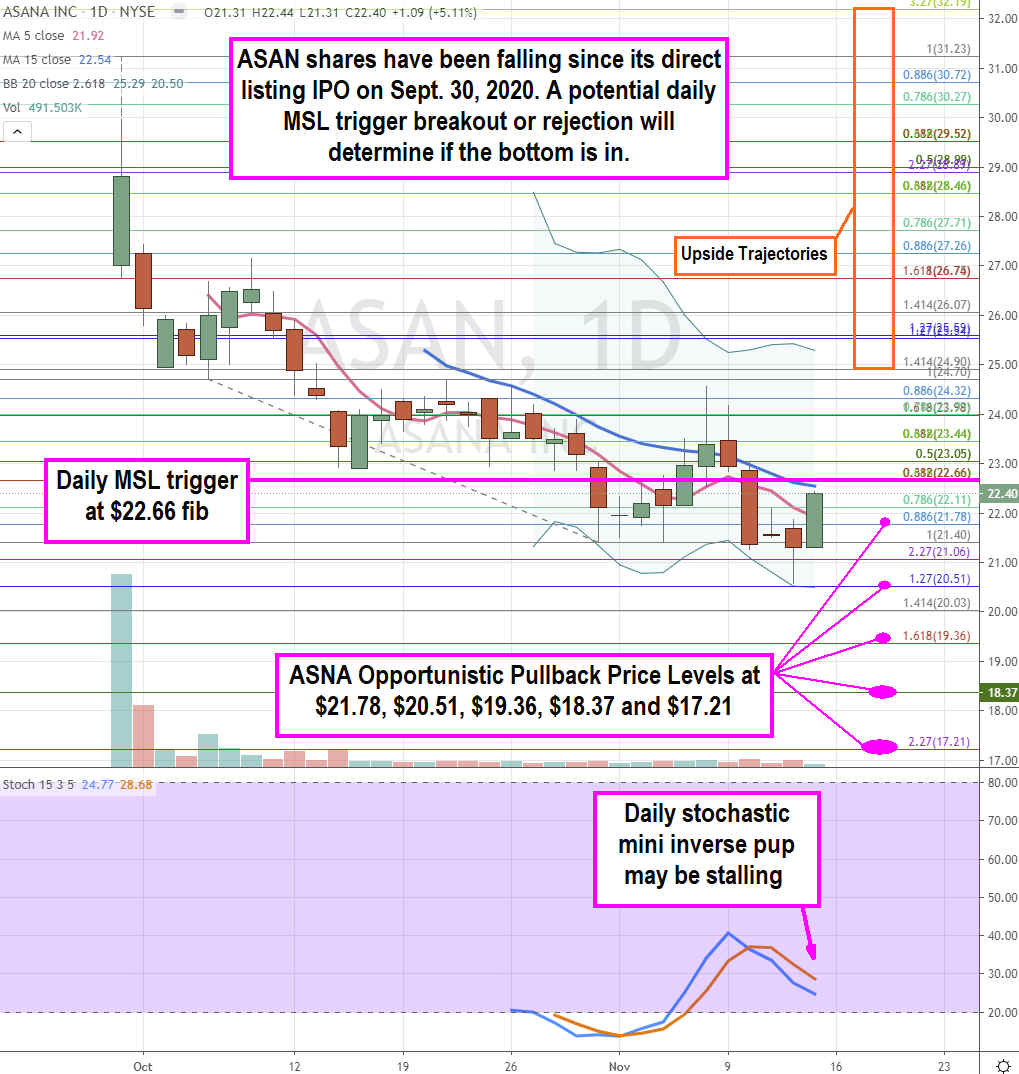Workflow management solutions provider
Asana, Inc. NASDAQ: ASAN stock went public through a direct listing process (DLP) on Sept.30, 2020 and has been plummeting since then. Investors assumed the Company would have been a benefactor with the
COVID-19 pandemic backdrop but its underperformance against the benchmark
S&P 500 index NYSEARCA: SPY says otherwise. Pandemic benefactors have been selling off as promising
COVID-19 vaccine approvals draw closer. The race between the quickly spreading third surge versus an approved
vaccine is getting even more heated as states and nations ponder reissuing stay-in-shelter mandates again. As COVID-19 cases rise,
work-at-home stocks are seeing money flow again. Asana shares may be forming a near-term bottom that prudent investors can monitor on opportunistic pullback levels to gain some exposure,
Direct Listing Process
Shares of Asana opened at $27 on Sept. 30, 2020. Shares spiked to a high of $31.23 briefly before commencing its descent. Unlike an IPO, a DLP forgoes the roadshows to drum up institutional demand or awareness or even involves underwriters or newly issued shares and no-lock up period. It also allows for shareholders including insiders to sell their stake right off the open. The Company also receives no proceeds. It’s meant to provide new investors an opportunity to take stakes in the Company and existing investors to have the liquidity to dump shares. This saves the Company from the expenses and legwork of an IPO, but also takes a risk as price stability and transparency disappear.
Company S-1 Details
Asana was the brainchild of Facebook NASDAQ: FB Co-Founder Dustin Moskovitz, whom launched the Company in 2008. The underlying goal of the platform is to make workers more efficient. The software has a goal of bringing efficiency and streamlined workflow to businesses of all sizes. According to the Company’s S-1 filings, fiscal 2020 revenues grew 86% year-over-year to $143 million, but losses also grew nearly 55% YoY to $118.6 million. Gross margins have improved to 87% in the first-half of fiscal 2021. The Company estimates fiscal 2021 revenues between $210 million to $213 million for a 47% to 49% YoY growth.
Asana has 82,000 paying customers and 3.5 million free-activated accounts. Approximately 2/3rds of the Fortune 500 companies use Asana. The Company derives 40% of its revenues internationally. Customers spending over $5,000 annually rose 65% year-over-year (YoY) to 7.933. Customers spending more than $50,000 annually grew 160% YoY to 283. Asana’s first earnings report as a publicly traded company is anticipated to be released in December 2020.
Analysts Initiations
On Oct. 9, 2020, analyst Bernstein initiated an Underperform rating with a $19 price target citing the rapid slowing of growth and limited competitive advantage in a crowded space. On Oct. 26, 2020, eight brokers initiated coverage on Asana shares. Ratings started with Piper Sandler at a Neutral rating with a $25 price target to Jeffries with a Buy rating and $30 target. On Nov. 11, Berenberg initiated coverage with a Buy rating and $30 target.
Peers To Monitor
The workflow management industry is crowded and competitive. Microsoft’s Team NASDAQ: MSFT product is only a drop in the bucket in the overall revenue picture. Investors should monitor the price action in Slack Technologies NASDAQ: SLACK and Smartsheet NYSE: SMAR as more pure-play stocks. The first earnings report should provide more color on the landscape moving forward. Prudent investors can watch for opportunistic pullback levels for exposure.

ASAN Opportunistic Pullback Levels
Using the rifle charts on the daily chart provides the immediate view of the playing field since the trading data is limited. The daily stochastic has crossed down and formed a mini inverse pup breakdown as the 5-period moving average (MA) consistently rejected every bounce attempt since its debut. A daily market structure low (MSL) buy triggers above the 22.56 Fibonacci (fib) level. A rejection of the MSL trigger can form opportunistic pullback levels at the $21.78 fib, $20.51 daily lower Bollinger Band/fib, $19.36 fib and the $17.21 fib. Since the market is still trying to find a bottom on ASAN, it’s important to watch the peers SLACK and SMAR to gauge price action and sentiment. As earnings release approaches, shares may start to accelerate higher. The bar is set by where the price and stochastic is going into the earnings report. WORK has a template of rising sharply into its earnings release and collapsing on a sell-the-news reaction. Use this as a template until proven otherwise if you take exposure ahead of the release.
MarketBeat just released its list of 10 cheap stocks that have been overlooked by the market and may be seriously undervalued. Enter your email address and below to see which companies made the list.
Get This Free Report
Like this article? Share it with a colleague.
Link copied to clipboard.